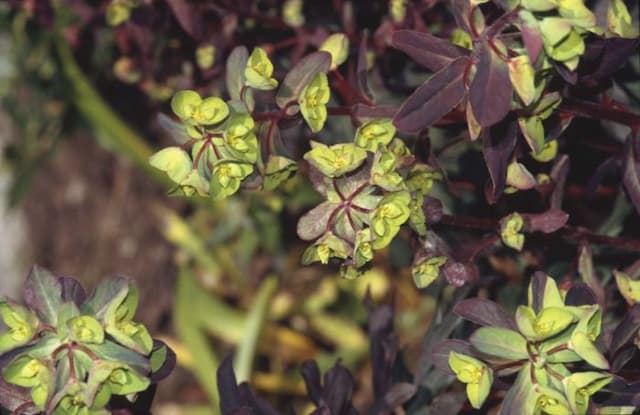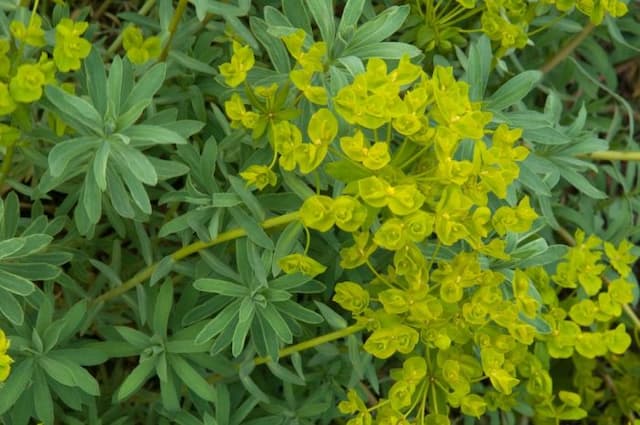Griffith's spurge Euphorbia griffithii 'Fireglow'

ABOUT
Euphorbia griffithii 'Fireglow' is an ornamental plant known for its vibrant and attractive appearance. The most striking feature is its fiery reddish-orange bracts that cluster around the small, yellowish-green actual flowers, creating a glowing effect that is especially vivid in the spring and early summer months. The bracts provide an extended period of interest, even after the true flowers have faded. The leaves of 'Fireglow' add to its beauty; they emerge with a reddish tinge in the spring and mature into a rich green with a subtle reddish outline along the veins as the season progresses. In the fall, the foliage turns to a stunning reddish-orange, echoing the colors of the bracts and giving the plant a secondary season of interest. The stems are sturdy, often taking on a reddish hue as they support the weight of the lush foliage and vibrant flower heads. The overall growth habit is clumping, with the plant producing a bushy appearance due to numerous stems emerging from the base. As a part of the Euphorbia family, 'Fireglow' exudes a milky sap when cut or broken, which is characteristic of this group of plants. This sap can be irritating to the skin and eyes, so caution should be used when handling or pruning the plant. 'Fireglow' has a resilient nature, able to tolerate a range of soil types provided they are well-draining. It enjoys full sun to partial shade and can be quite drought-tolerant once established. Overall, Euphorbia griffithii 'Fireglow' is a visually striking plant that brings a splash of warm, fiery colors to gardens and landscapes, providing a long-lasting display of interest from spring through fall without ever mentioning its size.
About this plant
 Names
NamesFamily
Euphorbiaceae
Synonyms
Griffith's Spurge, Fireglow Spurge, Fireglow Euphorbia
Common names
Euphorbia griffithii 'Fireglow'.
 Toxicity
ToxicityTo humans
The Fireglow spurge contains a toxic white latex sap that is present in all parts of the plant. If ingested, the sap can cause irritation to the mouth and throat, nausea, vomiting, and diarrhea. If the sap comes into contact with the skin, it can cause irritation, redness, and swelling. If it gets in the eyes, it can cause severe irritation and possibly temporary blindness. It's important to handle this plant with care and wash your hands after contact.
To pets
Fireglow spurge is also toxic to pets due to its white latex sap. If ingested by animals, it can cause similar symptoms as in humans: irritation of the mouth and gastrointestinal tract, resulting in drooling, vomiting, and diarrhea. If the sap comes in contact with the skin or fur, it can cause redness and swelling, and if it gets into the eyes, severe irritation can occur. Pets should be prevented from chewing on or ingesting any part of this plant.
 Characteristics
CharacteristicsLife cycle
Perennials
Foliage type
Deciduous
Color of leaves
Green
Flower color
Orange
Height
2-3 feet (0.6-0.9 meters)
Spread
2-3 feet (0.6-0.9 meters)
Plant type
Herb
Hardiness zones
5
Native area
Himalayas
Benefits
 General Benefits
General Benefits- Attractive Foliage: Euphorbia griffithii 'Fireglow' features vibrant green leaves that can add lushness and color contrast to garden settings.
- Striking Flowers: The plant produces fiery orange-red flowers in late spring and early summer, providing a vivid color display in the garden.
- Drought Tolerance: Once established, 'Fireglow' is quite drought-tolerant, making it suitable for xeriscaping or low-water gardens.
- Easy to Grow: This euphorbia is known for being low maintenance and easy to care for, requiring minimal attention once established.
- Pest Resistance: 'Fireglow' is generally resistant to pests, reducing the need for chemical treatments in the garden.
- Deer Resistance: The plant is not favored by deer, which can help prevent damage to your garden from grazing.
- Long Blooming Period: The long flowering season of Euphorbia griffithii 'Fireglow' ensures a lasting display of color.
- Versatile Planting: Suitable for borders, rock gardens, and as a focal point, this plant can adapt to various garden designs.
- Soil Adaptability: 'Fireglow' can thrive in a range of soil types, from clay to sandy soils, as long as the drainage is good.
- Suitable for Containers: It can be grown in pots or containers, providing flexibility for those with limited garden space.
- Seasonal Interest: In autumn, the foliage changes color, adding additional seasonal interest to the plant's yearly cycle.
 Medical Properties
Medical PropertiesThis plant is not used for medical purposes.
 Air-purifying Qualities
Air-purifying QualitiesThis plant is not specifically known for air purifying qualities.
 Other Uses
Other Uses- Artistic Dye: The vibrant colors of Euphorbia griffithii 'Fireglow' can be used to create natural dyes for fabrics or artworks, giving them a unique and organic hue.
- Photography Subject: The striking appearance of 'Fireglow' makes it an excellent subject for photographers, especially those interested in capturing the beauty of plants and gardens.
- Education: The plant's growth patterns and unique flowering can be used as an educational tool to demonstrate plant biology and ecology to students and enthusiasts.
- Companion Planting: 'Fireglow' can be used in companion planting to enhance the growth and health of other garden plants, providing mutual benefits.
- Habitat Creation: The dense foliage and flowers of 'Fireglow' can provide a microhabitat for insects and small wildlife within a garden setting.
- Garden Borders: The plant's bold and fiery color can be utilized to create striking borders and edges within garden landscapes.
- Craft Material: Dried stems and bracts of 'Fireglow' may be used in crafting, such as in making wreaths or other decorative items.
- Seasonal Decoration: During its blooming season, live or cut stems of 'Fireglow' can serve as stunning and vibrant decorations in seasonal floral arrangements.
- Erosion Control: The spreading habit of 'Fireglow' can be beneficial in sloped gardens, where it can help prevent soil erosion with its root system.
- Water Garden Accent: Although it is not an aquatic plant, 'Fireglow' can be planted near water features to add color and visual interest to water gardens.
Interesting Facts
 Feng Shui
Feng ShuiSpurge is not used in Feng Shui practice.
 Zodiac Sign Compitability
Zodiac Sign CompitabilitySpurge is not used in astrology practice.
 Plant Symbolism
Plant Symbolism- Persistence: Euphorbia griffithii 'Fireglow', commonly known as 'Fireglow' Spurge, is known for its resilience and ability to thrive in tough conditions, making it a symbol of persistence and enduring spirit.
- Caution: As a member of the Euphorbia family, 'Fireglow' Spurge exudes a milky sap when cut or damaged that can be irritating to the skin and eyes, symbolizing the need for caution and respect for nature’s boundaries.
- Transformation: The 'Fireglow' Spurge, with its fiery red-orange colors, symbolizes transformation and change, reflecting the plant's dramatic seasonal color shifts.
- Protection: The 'Fireglow' Spurge has a natural defense mechanism in its toxic sap, which symbolizes protection and the idea of safeguarding oneself against harm.
 Water
WaterThe Spurge 'Fireglow' prefers consistent moisture but does not like to be waterlogged. Water the plant deeply when the top inch of soil feels dry to the touch. In general, this may mean watering approximately once a week during active growth periods in spring and summer, with less frequent watering during the winter months when the plant is dormant. Depending on the pot size and the environmental conditions, you might need about 1 to 1.5 gallons of water every week during the growing season. Adjust watering habits to account for rain, heat, and the plant's location, ensuring you're not overwatering and risking root rot.
 Light
LightThe Spurge 'Fireglow' thrives best in full sun to partial shade. For optimal growth and flowering, aim to provide the plant with at least 6 hours of direct sunlight each day. A spot that receives morning sun and dappled afternoon shade would be ideal to protect it from the intense heat of the day, especially in hotter climates.
 Temperature
TemperatureThe Spurge 'Fireglow' can survive a range of temperatures but ideally prefers conditions between 60 to 75 degrees Fahrenheit. It can withstand occasional cold dips down to 30 degrees Fahrenheit but should be protected from prolonged freezing temperatures. To keep 'Fireglow' healthy, it is best to avoid exposure to extremes, particularly heat above 90 degrees Fahrenheit and extended cold below its minimum threshold.
 Pruning
PruningPruning the Spurge 'Fireglow' is mainly done to remove spent flowers and to maintain its shape. The best time to prune is in late winter or early spring before new growth begins. Deadheading, or cutting off the faded blooms, encourages more flowers and can be done throughout the blooming season. Also, remove any damaged or diseased stems as they appear to keep the plant healthy.
 Cleaning
CleaningAs needed
 Soil
SoilGriffith's Spurge 'Fireglow' thrives in a well-draining soil mix with a pH ranging from slightly acidic to neutral (pH 6.1 to 7.2). An ideal soil recipe would be a blend of garden soil, peat moss, and perlite or sand to increase drainage. Regular garden soil can be amended with organic matter such as compost to enhance fertility and structure.
 Repotting
RepottingGriffith's Spurge 'Fireglow' does not require frequent repotting and should be repotted only when it has outgrown its current container. This is typically every 2 to 3 years, and it's best to repot in the spring as the plant resumes active growth.
 Humidity & Misting
Humidity & MistingGriffith's Spurge 'Fireglow' is tolerant of a wide range of humidity levels and does not require any special humidity conditions when grown outdoors. It is quite adaptable and can thrive in the typical outdoor moisture levels.
 Suitable locations
Suitable locationsIndoor
Place in bright, indirect light and keep soil slightly dry.
Outdoor
Full sun to part shade; well-draining soil; water moderately.
Hardiness zone
5-9 USDA
 Life cycle
Life cycleEuphorbia griffithii 'Fireglow', commonly known as Griffith's spurge, starts its life cycle as a seed, often germinating in spring when soil temperatures warm up. Seedlings emerge and establish a root system before sending up shoots; this juvenile stage is characterized by rapid vegetative growth. As it matures, the plant develops characteristic red stems and lance-shaped green leaves, and in late spring to early summer, it comes into bloom with vibrant orange-red flowers that attract pollinators. After flowering, seeds are produced and dispersed, completing the reproductive cycle. The plant is perennial, so after summer, the aerial parts die back to the ground with the onset of autumn and winter, and it enters a dormancy period. With the return of spring, Griffith's spurge regrows from the rootstock, beginning the cycle anew.
 Propogation
PropogationPropogation time
Spring-Early Summer
Propogation: Euphorbia griffithii 'Fireglow', commonly known as Griffith's spurge, is best propagated by division, which should ideally be done in early spring as new growth begins. To propagate through division, dig up an established clump of the plant and carefully separate it into smaller sections, ensuring that each new division has a portion of the root system. These divisions can then be replanted into well-drained soil, spaced about 18 inches (approximately 45 cm) apart. It's important to handle the plant with care as the sap can be irritating to the skin and eyes. Water the newly planted divisions well to help establish them.









